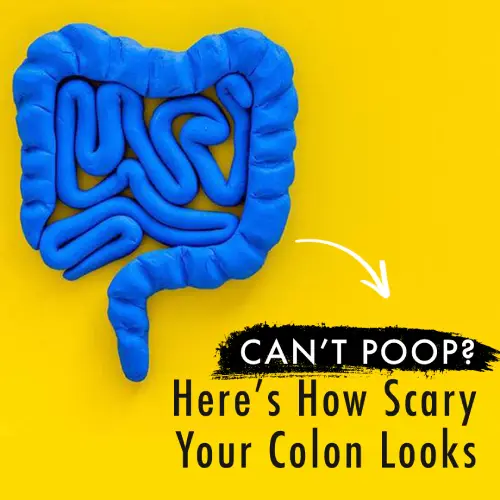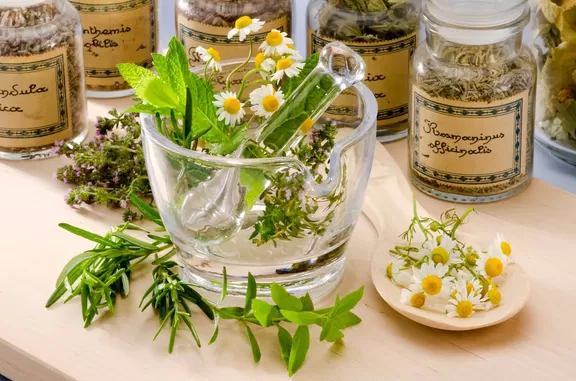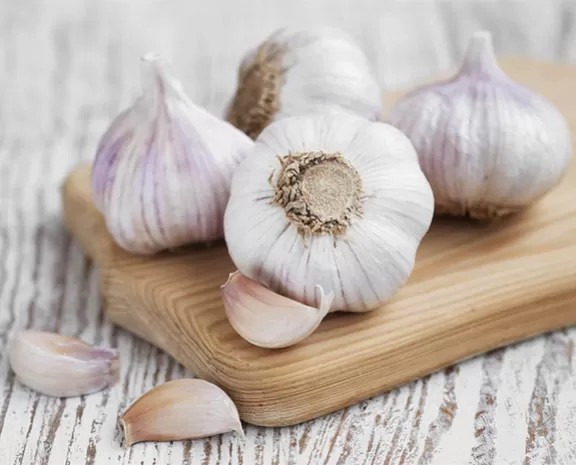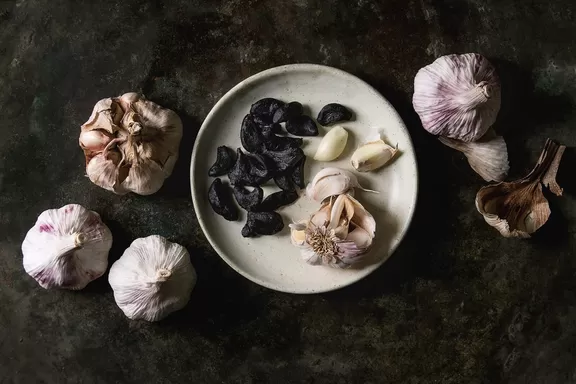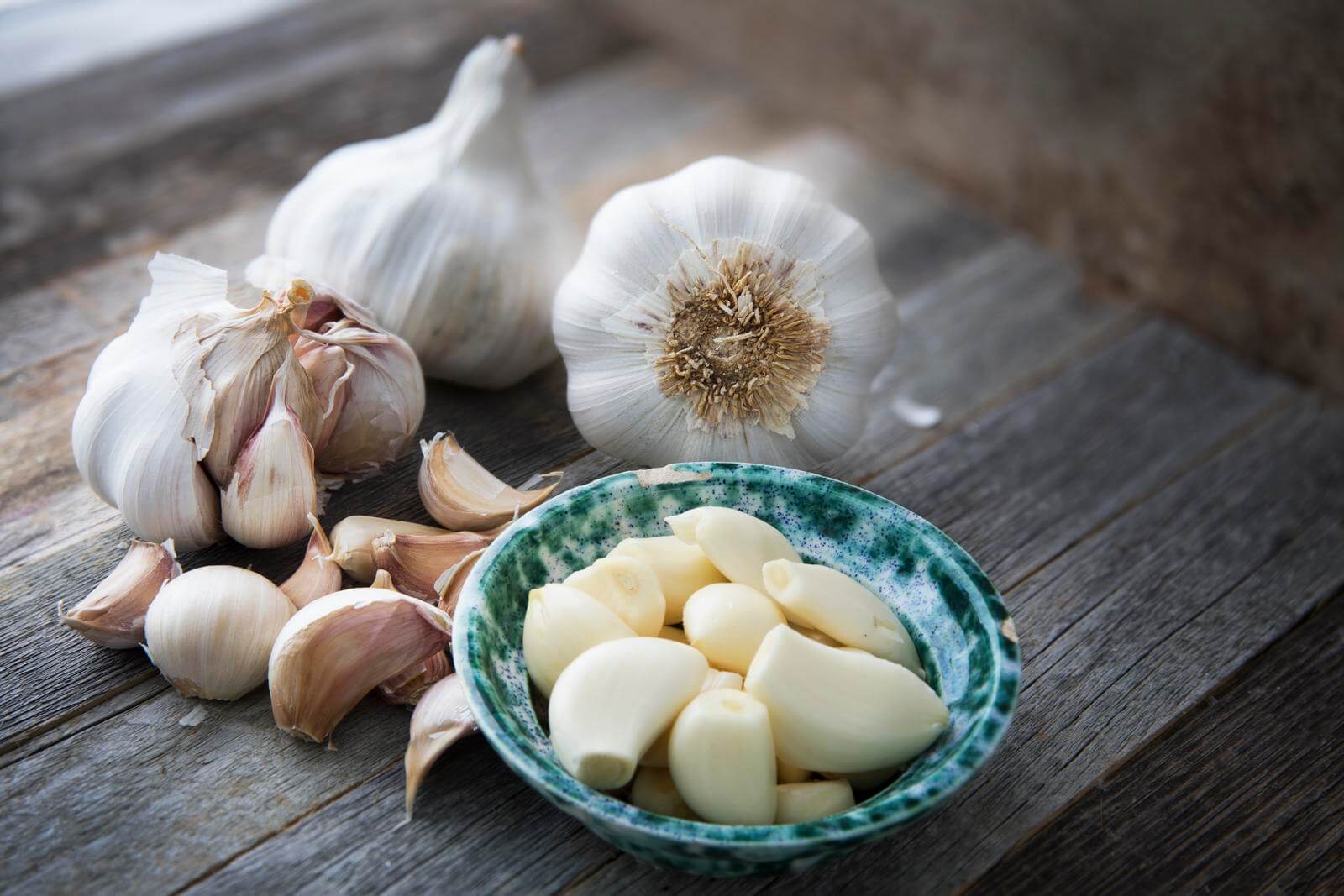
So, can garlic (Allium sativum) be used to treat hemorrhoids? It appears it certainly can! A 2021 study in The Scientific World Journal(source 1) and a 2014 study in the International Research Journal of Pharmacy(source 2) both state that garlic can be used as a treatment for hemorrhoids. And, garlic has been used since ancient times to treat hemorrhoids.(source 3)
Garlic probably works well for hemorrhoids due to its anti-inflammatory and wound healing properties. As we will discuss, garlic is a capable anti-inflammatory. Excessive inflammation might lead to additional swelling of the hemorrhoids, and eventually can cause tissue damage. Garlic is able to combat inflammation in different ways; and, research has proven the anti-inflammatory efficacy of garlic.
If you have hemorrhoids, you might also have minor wounds and bleeding. Garlic has been shown by scientific research to be an effective wound healing herb. For this reason, garlic can help mitigate aggravated hemorrhoids by promoting the healing process.
In addition to anti-inflammatory and wound healing abilities; garlic is also a potent antiseptic. Garlic is able to help treat different bacterial, fungal, and even viral infections. Thus, garlic will reduce your risk of developing a hemorrhoid infection. As you may have guessed, the antimicrobial ability of this herb is a complex topic that is beyond the scope of this article. Yet, Herbsey does have full articles dedicated to the antimicrobial nature of garlic:
How to Use Garlic For Hemorrhoids
To use garlic for hemorrhoids you can insert a clove of garlic into the rectum as a suppository. But if you do, make sure to not leave it in for more than a few hours. Additionally, if you start to feel discomfort, discontinue using garlic in this way. You may have developed a slight burn and need to heal.
Another way you can use garlic is by crushing it and diluting it with coconut oil to make a paste. When you do, consider adding in other herbs that help hemorrhoids; one of the best is comfrey (check out: Comfrey for Hemorrhoids). In lieu of coconut oil, aloe vera (check out: Aloe vera for Hemorrhoids) is another herb that can help with hemorrhoids you can mix the crushed garlic into.
Diluting the crushed garlic in some type of carrier medium should help attenuate your risk of developing a chemical burn. Additionally, by using multiple herbs that heal hemorrhoids simultaneously, they may produce a synergistic effect. Yet, experiential knowledge will have to reveal if this is the case, as currently there are probably no scientific studies to answer such questions.
Just remember, if you use crushed garlic, make sure to clean it off within a few hours and try to avoid applying this mixture too frequently. The idea is to avoid getting a chemical burn from overexposure! We will talk about the importance of safety in this context next.
Naturally Treat Hemorrhoids in 48 Hours
Jessica Wright’s unique 5-step, all-natural approach to hemorrhoid treatment delivers permanent relief. Heal hemorrhoids in 48 hours, and eliminate the root cause in 30 to 60 days.
Benefit from Jessica’s 12 years of research; her book is backed by a 60 day, 100% money back guarantee.

Important Cautions Before Using Garlic Rectally
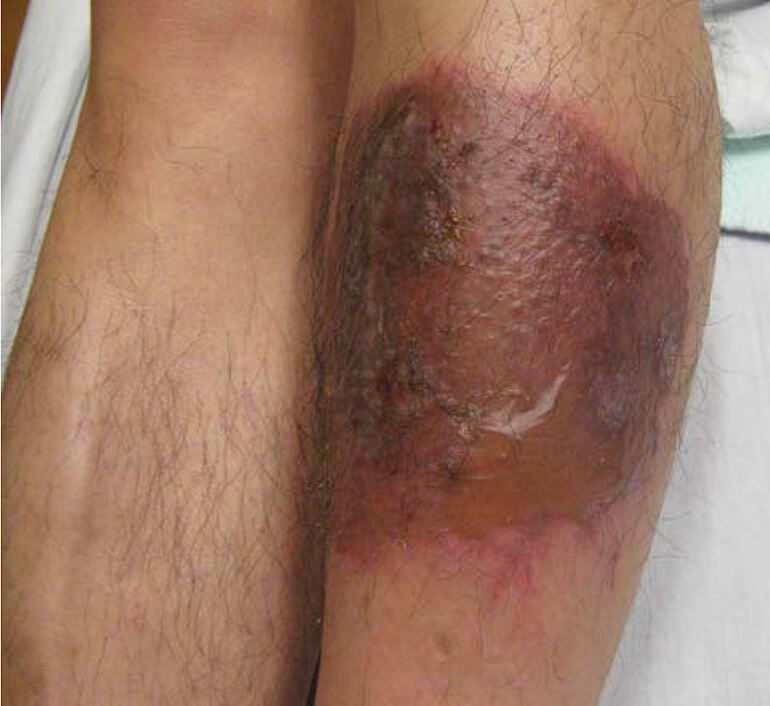
Image Source: Xu, Shuai, et al.; Dermatology Online Journal 20.1 (2014)(source 25)
When using garlic for hemorrhoids, there is an important word of caution to be aware of. Persistent contact with a peeled clove of garlic can cause burns to the skin! So, if you use garlic in the anal area for hemorrhoids improperly, you can end up with a severe problem.
Another example of the need for safety when using garlic in this fashion is a case report published in 2012 in Intestinal Research(source 4) explaining the situation of a man who suffered an ulcer from inserting a clove of garlic into his rectum for medicinal purposes.
This case report explained that rectal ulcers are rarely caused by lower gastrointestinal bleeding. The case report documented a 48 year old man who came to the emergency department with severe passage of blood from the anus and with hypovolemic shock (when you have lost so much blood the heart has difficulty pumping). This occured 5 days after inserting garlic into his rectum.
A 2021 review of case reports, published in The American Journal of Emergency Medicine,(source 5) looked at 39 different cases of garlic burns. These multiple case reports covered in this review shows us that garlic has the potential to damage skin.
A 2019 study in the Journal of Burn Care & Research(source 6) presents two cases of garlic burns. This study states the topical use of crushed garlic with a bandage is frequently done, especially in eastern cultures, to help relieve pain. Yet, some common harmful effects of garlic are allergic contact dermatitis and chemical burns.
The study goes on to state that allicin is an organosulfur compound that is present in crushed garlic. This chemical can cause burns to the skin; and, using bandages with crushed garlic will worsen chemical burns.
Given these case reports, it is important not to directly put crushed garlic in the rectal area for significant amounts of time. And, if you insert a garlic clove into the rectum to treat hemorrhoids, make sure to remove it after several hours.
It is important to remember that herbal remedies are often as potent as synthetic pharmaceuticals; and, they need to be respected. With proper safety measures in place, garlic should prove to be a helpful addition to a therapy regimen to treat hemorrhoids.
Samuel Bart’s Digestive Health Solution
Samuel Bart has always been passionate about plants and their ability to keep us healthy. He has put together some of the best natural ways that could help anyone support a healthy digestive system.
Samuel perfected an easy, yet powerful formula, which consists of amazing ingredients. Bart’s supplement is backed by a ironclad 60-day, money back guarantee.

Garlic’s Ability as a Wound Healer
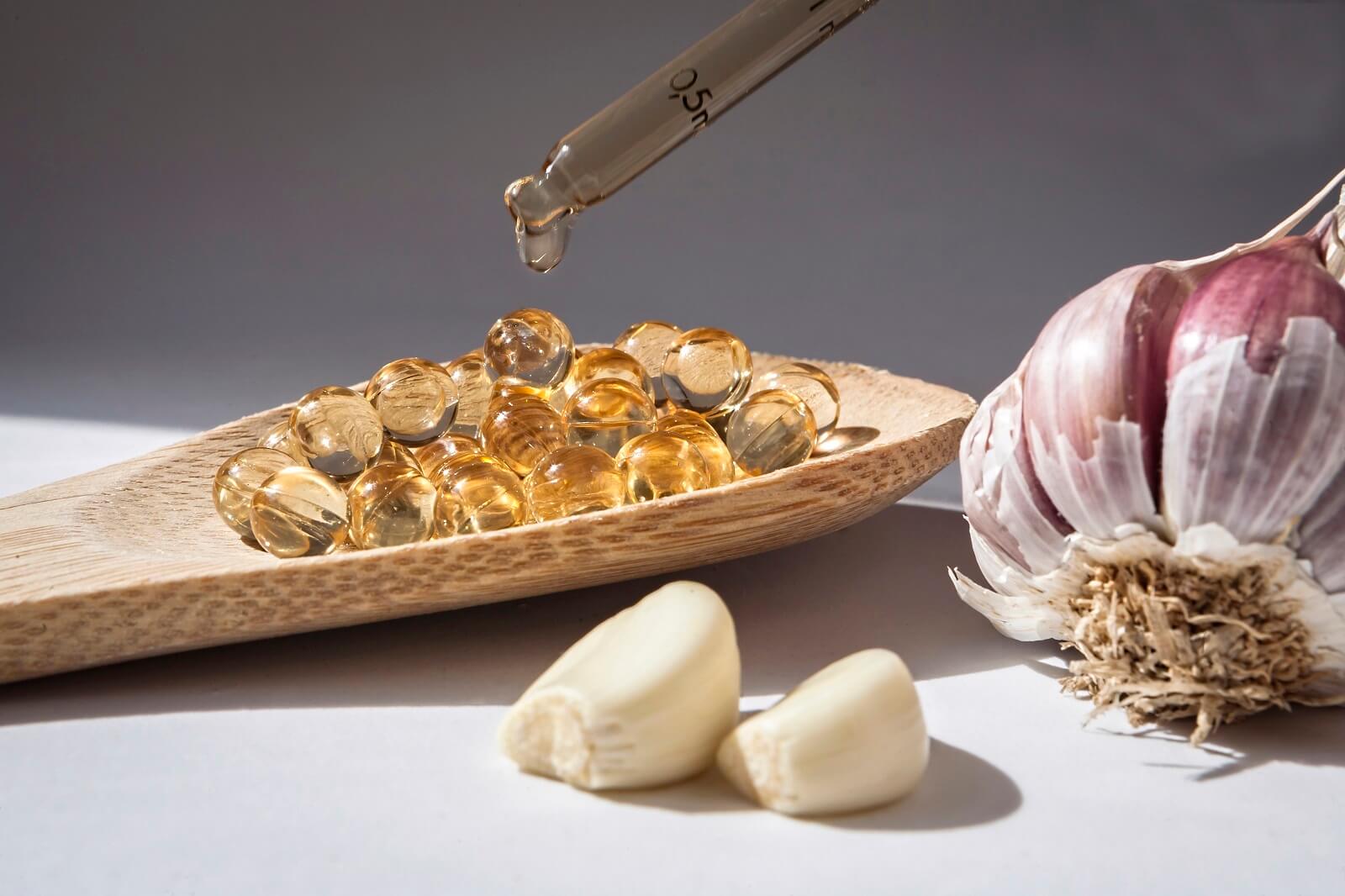
A 2009 study in Drug and Chemical Toxicology(source 7) investigated garlic’s ability to help heal wounds. This study used chickens for conducting their experiments. Chickens were given wounds and the test groups were given different concentrations (ranging from 1% to 15%) of aged garlic solution (AGS) as a wound treatment. The wounds of test group chickens were treated twice per day with AGS.
The study found that chickens given 15% AGS had about 80% re-epithelialization (the resurfacing of a wound with new epithelium; and, the epithelium of the skin is the tissue forming the outer layer of the skin’s surface(source 8)) at 4 days after wounds were inflicted. This same group had total re-epithelialization on day 6 after wounding.
Wound closure for chickens given AGS was better on day 4 compared to chickens in the control group (the control group was not given any type of wound treatment). 15% AGS produced a highly significant result of wound closure on day 4 with 75% wound contraction.
The study found an increase of the number of new loosely packed collagen (the primary structural protein in the skin) and the maturation of collagen bundles in all AGS treated wounds at day 4 after wounding. Additionally, concerning angiogenesis (the development of new blood vessels), all the AGS treated chickens showed a highly significant, substantial increase in blood vessels at wound sites.
The study concluded by stating:
Our findings provide new evidence demonstrating that AGS exposure can influence multiple aspects of wound healing. Since AGS is a complex mixture with many different chemicals, it might contain a chemical, or group of chemicals, that act a vital role in the stimulation of different important cascades of wound healing and angiogenesis.
Drug and Chemical Toxicology [32.3 (2009): 191-203]
Dr. John Herzog (MD)
Dr. John Herzog, a "survival surgeon" from Maine explains what home remedies work best in a crisis situation.
This may be important in the event you require first-aid or are in an emergency situation without easy access to a hospital. Dr. John Herzog has assembled a large collection of home remedies for such scenarios.

How Garlic Helps to Heal Wounds
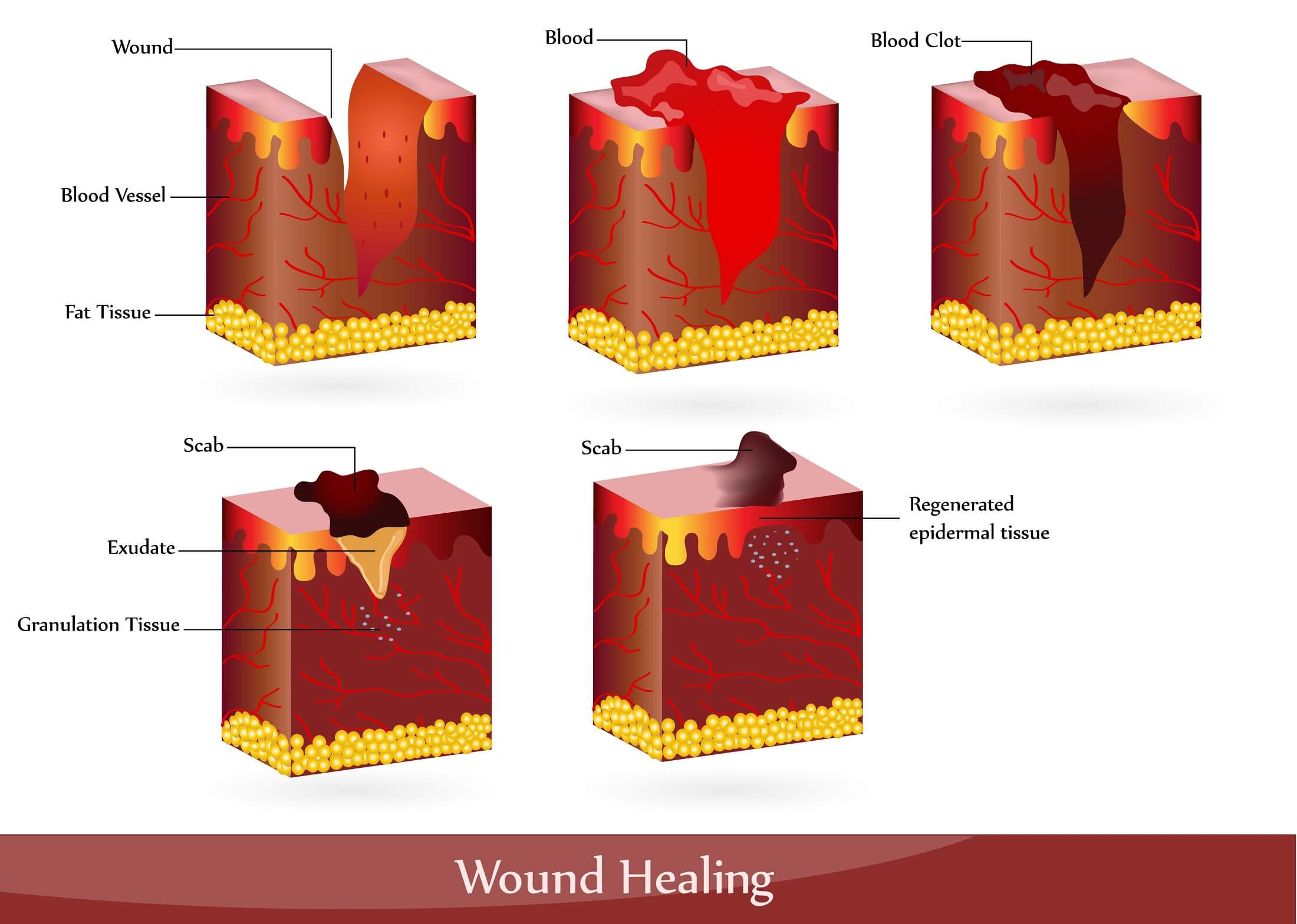
To learn more about wound healing phases, check out this StatPearls article on the topic!
As research will show, it appears that garlic helps expedite wound healing by increasing the number of proliferating fibroblasts and reducing inflammatory cells in wounds. The active constituent of garlic is allicin, and this may be the key reason garlic is efficacious as a wound healer.
A 2018 study in Dermatologic Surgery(source 10) stated that garlic has been shown in several studies to improve wound healing. The study also states that allicin, the chemical responsible for garlic’s strong smell, is an active component of garlic.
The study hypothesized that allicin acts on fibroblasts and this is how garlic helps heal wounds. Fibroblasts are a type of cell that helps form connective tissue; by secreting collagen proteins, these cells help maintain tissue structure.(source 9)
The study states that fibroblasts are found throughout the connective tissue; functioning to maintain the structural integrity of connective tissue by secreting proteins like collagen and glycoproteins. Because fibroblasts have such an important role in wound healing, the study’s authors hypothesized that these cells are activated by garlic; resulting in better wound healing.
The study made a 30% garlic ointment by combining 1 part crushed garlic with 2 parts Vaseline. The study kept the garlic refrigerated to help reduce allicin from decaying. The garlic ointment was considered expired after 2 weeks.
The study used rats to test their hypothesis, and inflicted wounds on the animals. The wounds were then treated with the garlic ointment or Vaseline. Each day the garlic ointment was used to treat the wound. After 14 days of receiving this treatment, biopsies (a tissue sample taken from the body) were taken from the wound areas.
The examination of the skin biopsies revealed that the garlic treated wounds had more proliferating fibroblasts than wounds receiving only Vaseline. But, there was no significant difference in the average number of fibroblasts from 2 week and 6 week biopsies.
In the conclusion the study cited another study that performed a similar experiment on dogs using purified allicin. This cited study found that allicin treated wounds had fewer inflammatory cells and more fibroblasts than those not receiving allicin.
Claire Goodall’s Amazing Guide
Clair Goodall is a bee-obsessed, natural medicine convert from Minnesota (USA). And, she does keep bees!
Clair has created 350+ page book documenting how to replace the toxic products and medications in your home with healthier, all-natural alternatives.

Garlic’s Anti-Inflammatory Properties
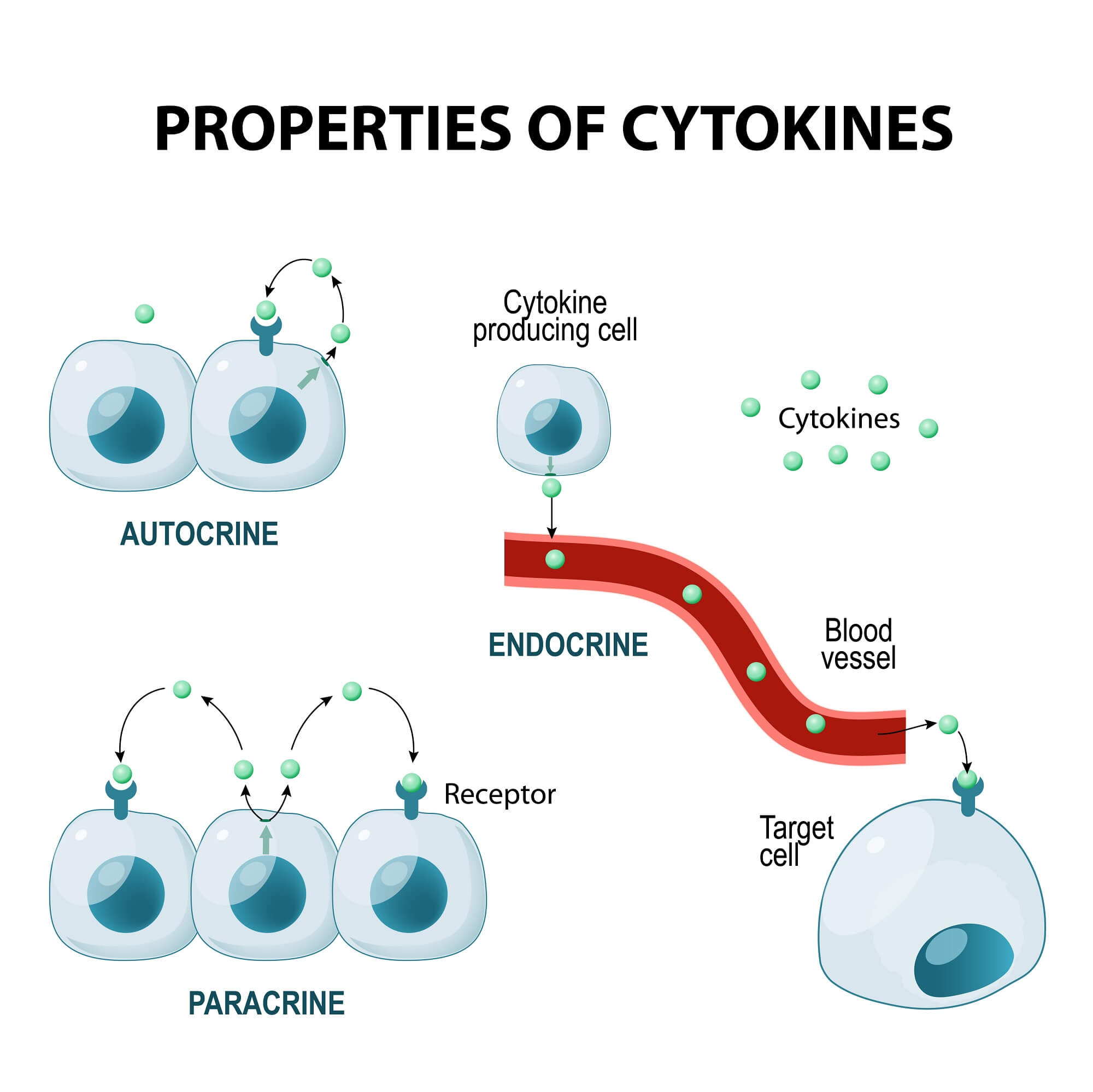
With a condition like hemorrhoids, it may be important to prevent tissue damage due to excessive inflammation. According to a 2006 study in Arthritis Research & Therapy(source 20) acute (intense and sudden) inflammation is a beneficial response, but chronic (long lasting) inflammation can eventually cause tissue damage.
A 2012 study in the Journal of Medicinal Food(source 11) states that a sulfur containing compound in garlic, ajoene (more specifically Z- and E-ajoene and oxidized sulfonyl derivatives of ajoene) work to suppress inflammation. It is somewhat complicated as to how this process actually unfolds, but let’s take a look briefly at some of the details explaining how ajoene stops inflammation.
The ajoene chemicals work to stop inflammation by inhibiting nuclear factor-κB (NF-κB) transcriptional activity (transcription in cellular function is the process by which DNA is copied into RNA which is then used to create proteins for the cell(source 12)).
NF-κB regulates many functions of the immune system; and, is a very important mediator of the inflammation response. NF-κB causes the expression of pro-inflammatory genes, including those responsible for cytokines (substances that are secreted by certain cells of the immune system and have an effect on other cells).(source 13)
The 2012 Journal of Medicinal Food study(source 11) also stated that the ajoene sulfur compounds inhibited the production of prostaglandin E2 (PGE2) and nitric oxide. It also inhibited the expression of pro-inflammatory cytokines interleukin-1β (IL-1β), and interleukin-6 (IL-6), and tumor necrosis factor-α (TNF-α).
Nitric oxide is relevant to inflammation in two ways. In normal physiological operation, nitric oxide has an anti-inflammatory effect. Yet, in abnormal situations, nitric oxide is considered a pro-inflammatory mediator that causes inflammation because it has been overproduced.(source 14)
PGE2 is a powerful inflammatory mediator that is produced by the enzyme cyclooxygenase 2 (COX-2) from arachidonic acid.(source 15) It is a lipid mediator that acts on various receptors to produce diverse effects that include inflammation, sensations of pain, and elevated body temperature.(source 16) Tissue swelling and redness come from the increased flow of blood into the inflammation site by PGE2 mediating an increase in microvascular permeability and changing arterial dilation.(source 17)
According to a 2022 StatPearls article about interleukin,(source 18) provided by the U.S. National Library of Medicine, interleukins are a type of cytokine produced by leukocytes (white blood cells) and by many other body cells. Interleukins are a large group of proteins that trigger many different reactions in cells by binding to receptors on the surface of cells.

Comprehensive Herbalist School
Dr. Patrick Jones, founder of the HomeGrown Herbalist School of Botanical Medicine has been a practicing veterinarian for over 25 years. He is also a clinical herbalist and traditional naturopath.
Kevin Harrington, Original Shark from ABC’s Shark Tank, stands behind Dr. Patrick Jones and HomeGrown Herbalist.
Learn More
Comprehensive Herbalist School
Dr. Patrick Jones, founder of the HomeGrown Herbalist School of Botanical Medicine has been a practicing veterinarian for over 25 years. He is also a clinical herbalist and traditional naturopath.
Kevin Harrington, Original Shark from ABC’s Shark Tank, stands behind Dr. Patrick Jones and HomeGrown Herbalist.Learn More
Interleukins have pivotal roles in the function of immune system cells; and, interleukins have pro-inflammatory and anti-inflammatory actions. The main function of interleukins is carried out during immune and inflammatory responses.
IL-1β is a cytokine that has powerful pro-inflammatory action. It is important for host defense responses to infection and tissue damage. IL-1β is produced by cells of the innate immune system (the innate immune system refers to the defenses your immune system had when you were born).(source 19)
IL-6 is produced in the area of inflammation and has an important role in the acute phase response (immune system and inflammatory processes, in response to infection or tissue damage, that are the first response of an organism in an attempt to heal itself). IL-6 also has an important role in chronic inflammation. In human inflammatory diseases, IL-6 levels are elevated.(source 20)
When IL-6 and IL-6 signaling is inhibited, this has been shown to be effective at preventing and treating models of inflammatory diseases.(source 20)
TNF-α is a pro-inflammatory cytokine that has different effects on certain cells. It is a major regulator of inflammatory responses; and can be a part of the development of some autoimmune and inflammatory diseases.(source 21)
More on Garlic Stopping Inflammation
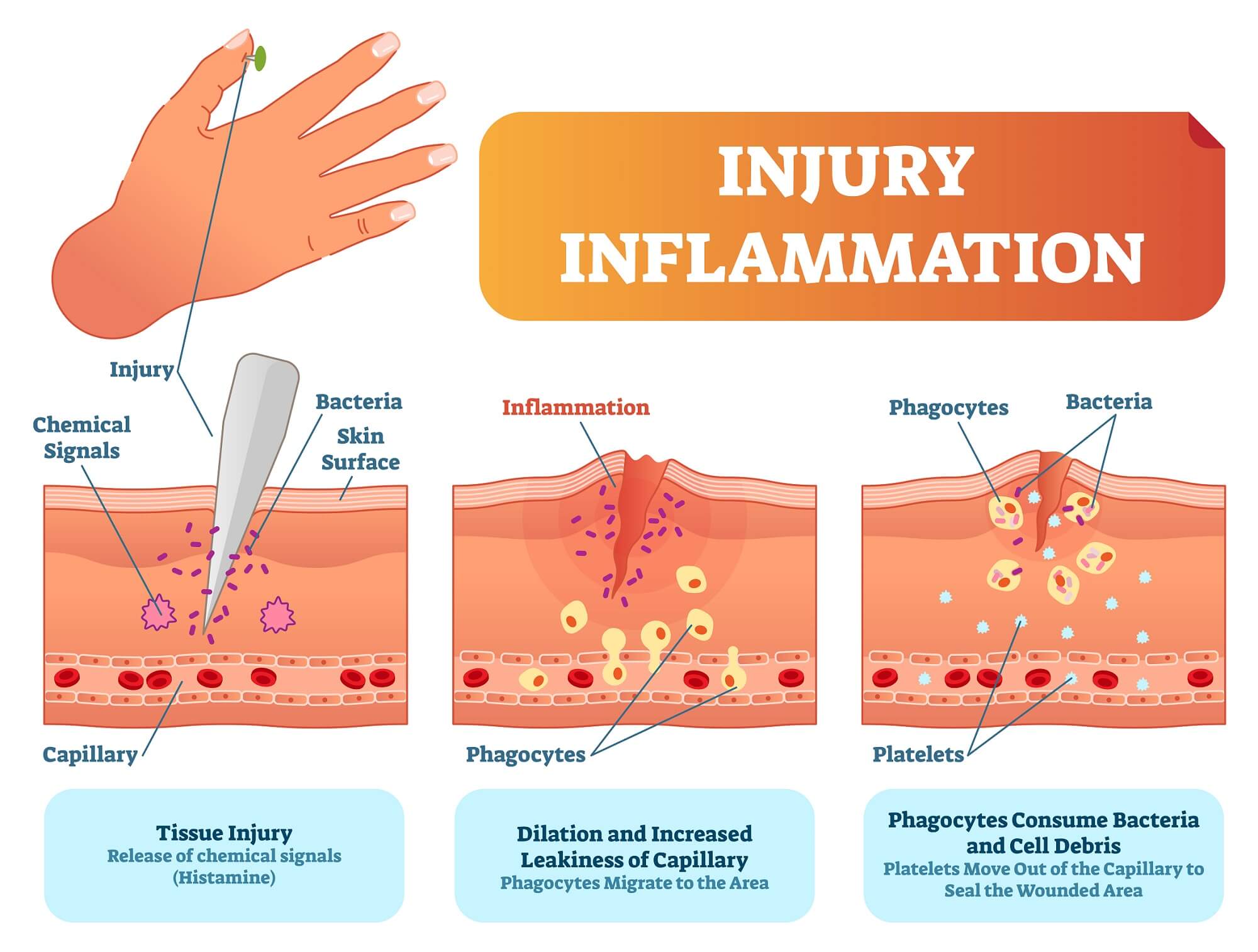
A 2005 study in Nutrition(source 22) looked at how organosulfur compounds that are derivatives of garlic oil would inhibit nitric oxide and PGE2 in mouse macrophages (specialized cells that detect, consume, and destroy harmful organisms). The chemical compounds examined were diallyl sulfide (DAS), diallyl disulfide (DADS), and allyl methyl sulfide (AMS).
The chemical allicin is found in crushed garlic and is highly therapeutic. Allicin is formed when the chemical alliin combines with the enzyme alliinase when garlic is crushed. The 2005 Nutrition study(source 22) states that one gram of crushed garlic would yield a dose of approximately 2 to 6 mg of allicin. Allicin is the precursor of DAS, DADS, and AMS.
It may be interesting to note that DADS and AMS have been associated with garlic breath and appear to exit through the skin; possibly contributing to foul body odor!(source 23)
The study found that DAS, DADS, and, to a lesser extent, AMS, have an influence on nitric oxide and PGE2 production in mouse macrophages.
DAS was found to inhibit nitric oxide and PGE2 production; but, neither DADS or AMS showed any effect on PGE2 production. DADS was found to suppress nitric oxide production. AMS was found to inhibit nitric oxide production primarily by nitric oxide scavenging.
The study stated that 1 gram of crushed garlic (resulting in approximately 2 to 6 mg of allicin) would provide enough allicin to, without considering digestion or absorption, result in approximately 1.8 to 5.4 micromoles of blood DADS concentration in a 70 kg individual. At this concentration, there would be enough DADS to inhibit nitric oxide production. Consequently, regular consumption of garlic would be beneficial in regards to inhibitory effects on excess PGE2 and nitric oxide production.
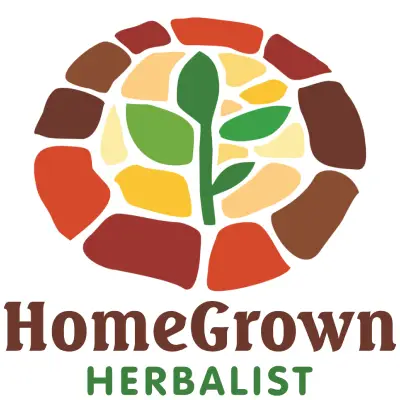
HomeGrown Herbalist Herb Shoppe
Owner of HomeGrown Herbalist Dr. Patrick Jones is a practicing veterinarian, Clinical Herbalist, and traditional naturopath. He owns and operates Fairview Animal Hospital in Buhl, ID.
Their herb shoppe provides herbs, essential oils, and tools. If you have some time, check it out!
Learn More
HomeGrown Herbalist Herb Shoppe
Owner of HomeGrown Herbalist Dr. Patrick Jones is a practicing veterinarian, Clinical Herbalist, and traditional naturopath. He owns and operates Fairview Animal Hospital in Buhl, ID.
Their herb shoppe provides herbs, essential oils, and tools. If you have some time, check it out!Learn More
A 2020 review study in Antioxidants(source 24) looked at studies published between the years 2000 and 2020 for information about garlic’s influence on human diseases. In this review, garlic’s anti-inflammatory properties were also analyzed.
The study states that various chronic diseases have inflammatory processes. For these diseases, garlic has demonstrated powerful anti-inflammatory ability by decreasing the inflammatory biomarkers in adult patients and in end-stage kidney disease. One study demonstrated garlic can significantly reduce inflammatory cytokines like IL-6. Additionally, the review found that garlic supplementation lowered blood concentrations of TNF-α.
Aged garlic also contains various chemical compounds that help to improve the immune system by modulating cytokine production. Consuming 2.56 g of aged garlic per day for 90 days was shown to increase the activity of immune cells and decrease inflammation by lowering IL-6 and TNF-α in obese adults.
Garlic’s Side Effects & Contraindications
There are some cautions you should be aware of when it comes to taking garlic. Fortunately, Herbsey has an article that provides a detailed summary of these side effects. You can read it (maybe just the short summary if you don’t have time!) here: Side Effects of Taking Garlic.
Generally you do not have to worry too much when taking a few cloves of garlic a day. The most common, and likely side effect, is having bad breath or bad body odor. But, if you use it on your skin, you should dilute the garlic, or use it with caution. This is because garlic can cause chemical burns.
Additionally, garlic may interact with blood thinners and drugs used to treat HIV. Also, garlic may prolong bleeding time and should be avoided before surgery. Again, the article has a more comprehensive explanation.
Heal Hemorrhoids Naturally in 48 Hours
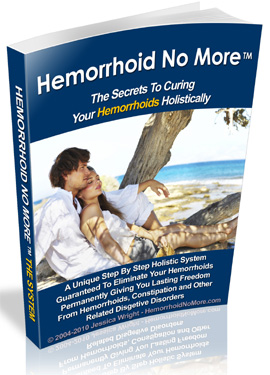
If you have tried "everything" to treat hemorrhoids, including surgery, but it didn’t work—your’re not alone. Jessica Wright experienced this same hardship due to hemorrhoids. But, with extensive research and understanding of natural medicine, she developed a solution to permanently end her hemorrhoids.
Jessica Wright wrote an entire book detailing exactly how to replicate her success. Also, it appears "Jessica Wright" is probably a pen name for a woman—and author—named Linda Allen. Linda suffered from recurrent yeast infections as well, maybe at the same time as she had hemorrhoids. She turned to natural medicine for answers when medical doctors and their solutions could not help.
Jessica’s story is one of severe and chronic hemorrhoids. It involves routine doctor’s visits, prescription medications / creams, significant suffering from hemorrhoids, and even a two hour hemorrhoids surgery (stapled hemorrhoidopexy). Yet, 12 years of these treatments didn’t resolve Jessica’s hemorrhoids.
Despite these setbacks, Jessica didn’t give up; instead, she turned to natural medicine and diligent research. Skipping to the end of Jessica’s story, she would develop a natural method to treat hemorrhoids that worked brilliantly.
After Jessica put together her treatment protocol and used it, she found her hemorrhoids completely disappeared. And, they stayed gone. Something her doctor was not able to do. Yet, all it took was the right natural therapeutic approach.
Jessica also gave her treatment approach to others; and, they experienced the same exceptional results. Typically, Jessica’s system provides dramatic relief of hemorrhoids in just 48 hours. And, the root cause of hemorrhoids is fixed within 30 to 60 days.
A company selling hemorrhoid symptom products does not want their customer base diminished. Consequently, unpatentable natural medicine does not get much attention or publicity.
So, how can you know if Jessica Wright’s claims are legitimate and not a scam? That is a great question. Here are 3 important reasons why Jessica’s book is legitimate:
- It is published by a large U.S. based company (Located in Idaho) known as ClickBank. ClickBank handles all the sales and refunds of many products like Jessica’s. They do business in many countries; and, have been in business for many years.
- ClickBank provides a 60 day, 100% money back guarantee on all their products, Jessica’s book included.
- If you are not satisfied with Jessica’s book you can simply contact ClickBank (they make it very easy) for a full refund.
Jessica’s story is more in-depth than this concise overview. And, there are additional bonuses Jessica provides with her book. If you’d like to find out more about Jessica’s personal story or her hemorrhoid treatment; you can learn more at Jessica Wright’s website.
About the Author
Nick Gross is a natural medicine enthusiast who has been researching and writing about natural medicine since 2008. Nick is primarily a web developer, but also researches and authors written and video content about natural health. Nick has a bachelor’s degree in Management Information Systems from the University of Northern Iowa.
More on Nick GrossImportant Disclosures & Disclaimers
It is important to use the information you find on Herbsey.com in the right way. Also for legal reasons, these disclaimers and disclosures are necessary. For further information about each, feel free to click the link provided to the page on this website that provides more information.
Medical Disclaimer
The information on this website is not a prescription for anyone. This information is for informational or educational purposes only, and is not a substitute for professional medical advice or consultations with healthcare professionals.
Advertisement Disclosure
Some of the links provided on this article and website are affiliate links. If you purchase a product after clicking on these links, Herbsey.com will earn a commission. Herbsey.com promotes various products through advertisement and text links. For more information: Our Advertisements.



